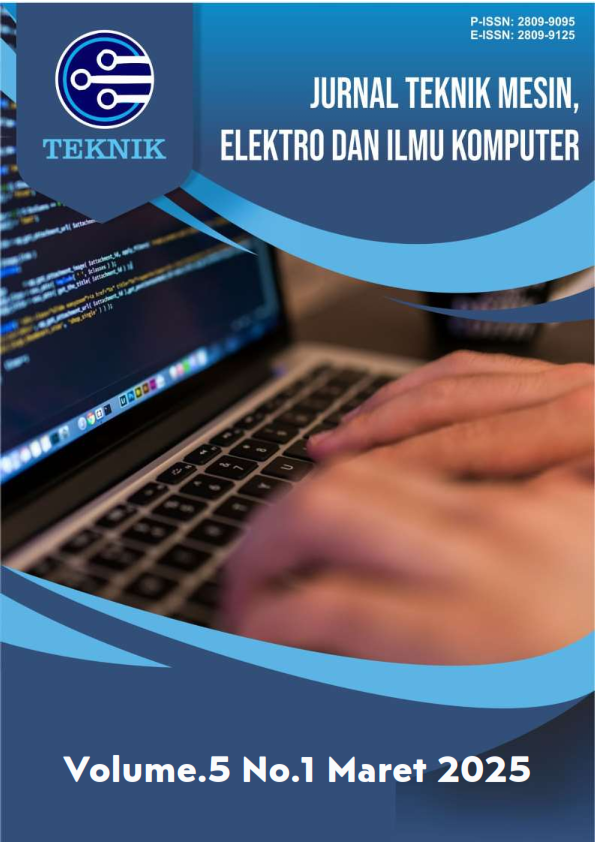Analisis Risiko Penyebab Kegagalan Pipa Penyalur Crude Oil
DOI:
https://doi.org/10.55606/teknik.v5i1.5732Keywords:
Failure Analysis, API 5L Grade B, Crude Oil, Internal Corrosion, Distribution PipesAbstract
The distribution pipe refers to API 5L Grade B standard, 8 inches in diameter, has a length of 212 km. The design life of pipe is 20 years, but after being operated, there were two leaks in this segment in one year. This condition resulted in disruption of oil deliveries. Research is needed to determine the cause of pipe failure before its design life. Pipe samples are subjected to visual observation, thickness test, chemical composition of the pipe, microstructure test, Characterization test of pipe corrosion product deposits. Produced water are testing to determine anions, cations and the tendency for scale formation with Valone & Skillern references. The visual test results showed that the inside of the pipe was thinning at 6 o'clock. Chemical composition testing showed that there was no difference in chemical composition with API 5L Grade B standards. SEM results in the leak area revealed the corrosion morphology caused by dissolved CO2. XRD analysis of the corrosion deposits formed were siderite (Fe2CO3), hematite (Fe3O4) and iron (Fe) compounds. Pipe failure occurs due to corrosive substances in the form of produced water. This situation causes the surface of the pipe to be exposed to produced water at the 6' o'clock position, initiating the formation of hydrogen ions (H+) and ions (HCO3-).
References
Abarua, G., & Nirmala, G. (2022). Analisa perbandingan fluida pada Sumur X dan Sumur Z. Prosiding Seminar Nasional Teknologi Energi dan Mineral, 110–115.
Adiman, M. F. (2022). Kajian risiko kegagalan pada proses pengolahan minyak bumi di unit utilities PT Kilang Pertamina Internasional RU VI Balongan dengan menggunakan metode Failure Mode and Effect Analysis (FMEA) [Skripsi, Institut Teknologi Sepuluh Nopember].
Azevedo, C. R. F. (2007). Failure analysis of a crude oil pipeline. Engineering Failure Analysis, 14(6), 978–994. https://doi.org/10.1016/j.engfailanal.2006.12.001
Challa, V. S. A., Yashwanth, I. V. S., Mendoza, K. L., & Stafford, S. (2016). Failure investigation of hydrotest rupture on a natural gas pipeline. Journal of Failure Analysis and Prevention, 16(5), 858–863. https://doi.org/10.1007/s11668-016-0164-4
Di, J. S. G., & Fraser, J. P. (1974). Corrosion tests in the Gulf floor. ASTM Special Technical Publication, STP 558, 185–208. https://doi.org/10.1520/STP32164S4
Ilman, M. N., & Kusmono. (2014). Analysis of internal corrosion in subsea oil pipeline. Case Studies in Engineering Failure Analysis, 2(1), 1–8. https://doi.org/10.1016/j.csefa.2013.12.003
Jafari, H., Danaee, I., Eskandari, H., & RashvandAvei, M. (2014). Combined computational and experimental study on the adsorption and inhibition effects of N2O2 Schiff base on the corrosion of API 5L Grade B steel in 1 mol/L HCl. Journal of Materials Science & Technology, 30(3), 239–252. https://doi.org/10.1016/j.jmst.2014.01.003
Lu, Y., Wang, Z., Jiang, J., Dou, Z., Xue, A., & Wang, J. (2018). Corrosion of sedimentary liquids on internal bottom plate of tanks among coal liquefaction process. Process Safety Progress, 37(4), 506–517. https://doi.org/10.1002/prs.11968
Nasrazadani, S., Akhtar, M. A., Patel, A., & Ezell, C. (2018). Failure analysis of API 5L (Grade B) oil field separator flowline pipe. Journal of Failure Analysis and Prevention, 18(4), 721–726. https://doi.org/10.1007/s11668-018-0454-0
Nešić, S., Cai, J., & Lee, K.-L. J. (2005). A multiphase flow and internal corrosion prediction model for mild steel pipelines. NACE - International Corrosion Conference Series. https://www.scopus.com/inward/record.uri?eid=2-s2.0-84923534673&partnerID=40&md5=a98264f46e8e897ba5eba9fecc04e23d
Ossai, C. I., Boswell, B., & Davies, I. J. (2015). Pipeline failures in corrosive environments – A conceptual analysis of trends and effects. Engineering Failure Analysis, 53, 36–58. https://doi.org/10.1016/j.engfailanal.2015.03.004
Rao, T. S., Sairam, T. N., Viswanathan, B., & Nair, K. V. K. (n.d.). Carbon steel corrosion by iron oxidising and sulphate reducing bacteria in a freshwater cooling system.
Shabarchin, O., & Tesfamariam, S. (2016). Internal corrosion hazard assessment of oil & gas pipelines using Bayesian belief network model. Journal of Loss Prevention in the Process Industries, 40, 479–495. https://doi.org/10.1016/j.jlp.2016.02.001
Sholihin, M. Y. M., & Aljabbar, R. (2023). Analisis potensi risiko lingkungan segmen rivercrossing pipa penyalur gas diameter 30 inchi akibat penipisan ketebalan karena korosi pada PT. XX dengan metode PIMS. Journal of Systems Engineering and Management, 2(1), 1–11.
Sholihin, M. Y. M., Kusyanto, H. S., & Soegijono, B. (2018). Analysis of the remaining life of API 5L grade B gas pipeline in the flare gas recovery unit. IOP Conference Series: Materials Science and Engineering, 432(1), 012016. https://doi.org/10.1088/1757-899X/432/1/012016
Valone, F. W., Skillern, K. R., Laboratories, B., & Spe-Aime, M. (n.d.). An improved technique for predicting the severity of calcium carbonate.
Wang, S., Chen, S., Li, Y., & Qi, J. (2015). Managing internal corrosion of mild steel pipelines in CO2-enhanced oil recovery multiphase flow conditions. Energy Technology, 3(3), 225–233.
Wang, S., Chen, S., Li, Y., & Qi, J. (2020). Advances in corrosion and prevention of a small-bore piping. Cailiao Daobao/Materials Reports, 34(19), 19166–19172. https://doi.org/10.11896/cldb.19060044
Wijayanto, S. O., & Bayuseno, A. P. (2013). Analisis kegagalan material pipa ferrule nickel alloy N06025 pada waste heat boiler akibat suhu tinggi berdasarkan pengujian: Mikrografi dan kekerasan. Jurnal Teknik Mesin, 1(4), 33–39.
Wilson, K., Jawed, M., & Ngala, V. (2013). The selection and use of cathodic protection systems for the repair of reinforced concrete structures. Construction and Building Materials, 39, 19–25. https://doi.org/10.1016/j.conbuildmat.2012.05.037
Downloads
Published
How to Cite
Issue
Section
License
Copyright (c) 2025 Jurnal Teknik Mesin, Elektro dan Ilmu Komputer

This work is licensed under a Creative Commons Attribution-ShareAlike 4.0 International License.








